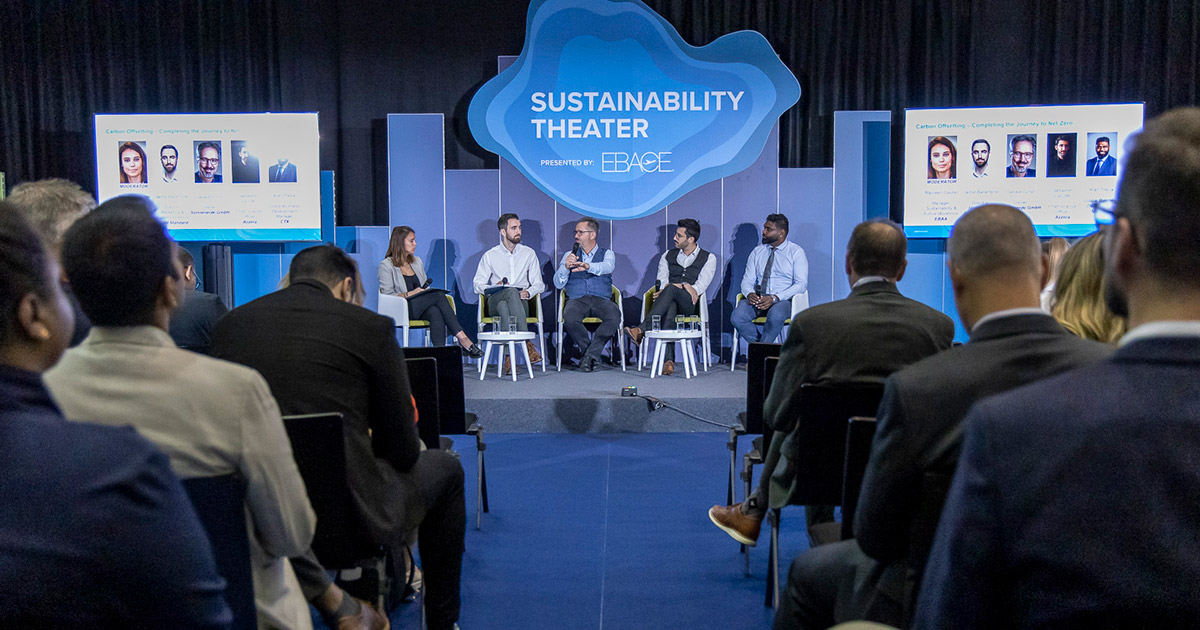Carbon Offsets Should Be Part of a Robust Sustainability Strategy

Moderator: Maureen Gautier; Panelists: Jamie Ballantyne, Gerald Dunst, Sébastien Lacube, and Aran Theva
24 May 2023
Most business aircraft operators planning their strategies for reaching net-zero carbon emissions focus on fuel reduction or buying sustainable aviation fuel (SAF). Flight operations looking to take it to the next level often purchase carbon offsets.
“Carbon offsetting is not a passport for business as usual, otherwise we’ll never reach net zero. We really have to reduce first,” said EBAA’s Maureen Gautier, manger, sustainability and future workforce. Providing information to operators who are ready to learn more about the world of offsets, Gautier moderated a 2023 European Business Aviation Convention & Exhibition (EBACE2023) panel discussion on 24 May, where experts answered questions about what offsets are, how they work and how to get started.
In a nutshell, purchasing carbon offset credits makes it possible for operators to write off their CO2 emissions on paper – moving them closer to net zero. Websites offer verified carbon credits for purchase that fund specific, approved projects that remove CO2 from the atmosphere.
As business aviation aims to reach its goal of net-zero carbon emissions by 2050, the precise amount of carbon offsets purchased by the industry is unclear, but “the overall size of the voluntary carbon market in 2001 was about $2 billion,” said Jamie Ballantyne, director of marketing and communications at voluntary carbon offset program Gold Standard. “Projections are for it to grow between 10 and 100 times by 2030.”
Fear may be one reason why aviation isn’t fully embracing carbon offsets.
“A lot of people are scared about buying something which is intangible. For many people, [buying offsets] is just a number. But people really forget that there’s a real project behind it,” said Sébastien Lacube, chief science officer at Azzera, a centralized carbon market spot exchange based in Canada and Switzerland.
Panelist Gerald Dunst’s soil company Sonnenerde is among the many that offer carbon credits for purchase. The Austrian company produces a product called biochar, a man-made soil that can capture CO2 from the environment and store it long term.
“This is one of the few possibilities for bringing carbon back where it belongs – into the soil – while at the same time, creating very fertile soil that can help ensure food security in the future,” Dunst said.
A Matter of Trust
Operators looking to get started should first assess their emissions, said Aran Theva, global business development manager at Carbon Trade Exchange (CTX), an online marketplace for trading carbon credits.
“We have an online tool that will help you with that. Then, set a budget. You can invest in [projects linked to things such as] nature and renewable energy,” Theva said. “What we say is: ‘Invest in multiple things at the same time, so you can have all the benefits possible, right?’ And then this can also be tailored to your budget.”
Nonetheless, operators still express hesitancy, even though the most trusted sites offer only verified projects.
“Trust is the most important thing in the carbon market. You can’t touch a ton of CO2 that hasn’t been emitted. So, it’s really important that we go through these difficult hoops to jump through in order that people can be sure that when they purchase a product, they know that they’re buying what it says it is,” said Ballantyne. Gold Standard requires its projects to pass through four stages of verification which are overseen by three different organizations.
Lacube stressed that offsets should be part of an overall net-zero strategy and urged owners to “do everything you can do. If you can reduce [fuel use] within your value chain, procure renewable energy and compensate the rest. You’ve done everything that can be done. And then next year, do more.”


